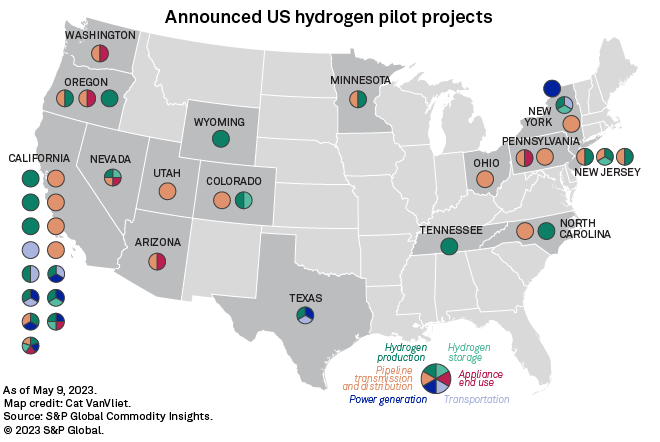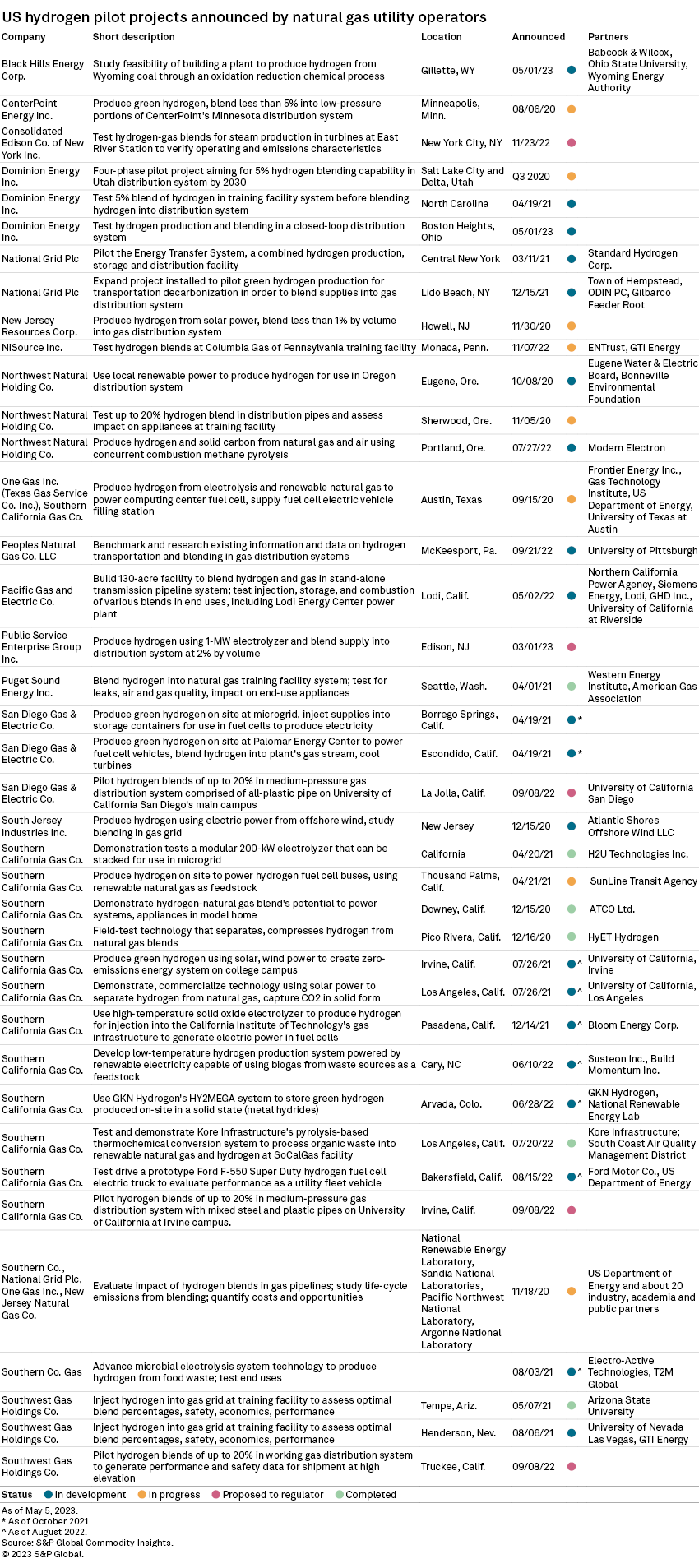S&P Global Offerings
Featured Topics
Featured Products
Events
S&P Global Offerings
Featured Topics
Featured Products
Events
S&P Global Offerings
Featured Topics
Featured Products
Events
Banking & Capital Markets
Economy & Finance
Energy Transition & Sustainability
Technology & Innovation
Podcasts & Newsletters
Banking & Capital Markets
Economy & Finance
Energy Transition & Sustainability
Technology & Innovation
Podcasts & Newsletters
S&P Global Offerings
Featured Topics
Featured Products
Events
17 May, 2023
Gas utilities have announced more than three dozen hydrogen pilot projects across the US as the industry continues to explore the fuel's potential to decarbonize distribution systems.
Reflecting that goal, more than half of the 39 projects identified by S&P Global Commodity Insights were focused on blending low- or zero-carbon hydrogen with natural gas into pipeline networks. Gas utilities have announced at least 22 pipeline blending projects through April, up from 13 pilots in October 2021, when Commodity Insights last published data.
Pipeline blending has the potential to reduce the carbon intensity of the nation's gas grids because hydrogen does not release CO2 during combustion. However, research has shown that pilots are needed to fill substantial knowledge gaps about hydrogen's impact on gas infrastructure and leakage rates, particularly at blends greater than 5% of total volume.
Many climate activists and safety advocates argue that low-carbon hydrogen should be reserved for hard-to-electrify applications, including high-heat industrial processes and heavy transport. Some investors also remain unconvinced that hydrogen will catch on for heating in residential and commercial buildings.

Blending pilots gain momentum
Pipeline blending pilots were among the earliest projects that gas distributors announced. They included projects to blend small amounts of hydrogen into working gas systems by CenterPoint Energy Inc. and New Jersey Resources Corp., as well as research into hydrogen blending at higher volumes in testing facilities operated by utilities such as Dominion Energy Inc., Northwest Natural Holding Co. and Southwest Gas Holdings Inc.
Since the end of 2021, National Grid USA, PG&E Corp., NiSource Inc., Peoples Natural Gas Co. LLC and Public Service Enterprise Group Inc. have launched similar programs and studies.
When Commodity Insights first published data in October 2021, most of the pilot projects were focused on producing clean hydrogen. That remains either the focus or a component of 23 projects. In some cases, gas utilities are producing zero-carbon green hydrogen from renewable electricity to use in pipeline blending pilots.
Hydrogen production remains a focus for Southern California Gas Co. (SoCalGas), which was once again the most active gas utility in the space. The company is operating at least 12 pilot projects and financially supporting several others focused on developing hydrogen end uses in the transportation and industrial sectors.
But as the hydrogen opportunity came into sharper focus, SoCalGas has built on its early research into hydrogen blending and joined other utilities in advancing pipeline blending studies.
Regulation grows more defined
SoCalGas, along with Southwest Gas Corp. and fellow Sempra subsidiary San Diego Gas & Electric Co., sought permission from California regulators to operate pipeline blending pilots in working gas systems. The companies are retooling their proposals after the California Public Utilities Commission outlined project criteria in an order directing the state's gas utility operators to pilot hydrogen blending.
Several gas utility operators have requested or received cost recovery for pipeline blending projects, with total project costs ranging from $2 million to nearly $29 million.
SoCalGas additionally proposed the nation's largest green hydrogen infrastructure project in Los Angeles. The Angeles Link proposal drew early support from regulators, who saw the potential for the transmission project to bolster California's bid for a portion of $8 billion in US Energy Department funding earmarked to develop regional hydrogen hubs.
Many of the other gas utilities piloting hydrogen blending are also supporting regional applications to the program. The inclusion of a hydrogen production tax credit in the sprawling Inflation Reduction Act has also encouraged gas utility executives.
The provision was a "massive accelerant" for hydrogen blending, National Grid PLC Chief Strategy and Risk Officer Ben Wilson told Commodity Insights in December 2022.
Multi-utilities are increasingly piloting hydrogen blending in gas turbines to decarbonize gas-fired power plants. Commodity Insights included some of those projects in its 2021 roundup but has excluded the projects in this update.
Still, about a quarter of the pilot projects have some power generation application, including for use in fuel cells. Commodity Insights included in this category a pilot project proposed by Consolidated Edison Co. of New York Inc. to decarbonize its Manhattan, NY, steam system by using hydrogen blends in steam generation.
Commodity Insights also observed a slight uptick in projects assessing hydrogen's impact on end-use appliances since 2021, while the number of pilots studying vehicle transportation and storage remained roughly steady.

S&P Global Commodity Insights produces content for distribution on S&P Capital IQ Pro.
